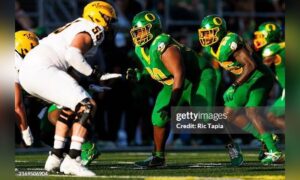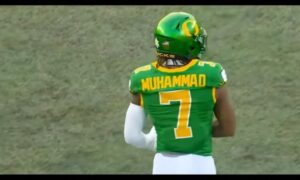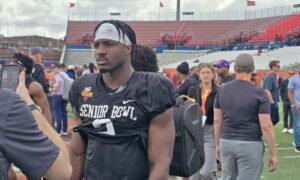From now until the 2022 NFL Draft takes place, we hope to scout and create profiles for as many prospects as possible, examining their strengths, weaknesses, and what they can bring to an NFL franchise. These players could be potential top 10 picks, all the way down to Day 3 selections and priority undrafted free agents. Today, I’ll be profiling Oregon CB Mykael Wright.
#2 Mykael Wright, CB, Oregon (Jr.) — 5110, 178 lbs.
Combine
Measurements
| Player | Ht/Wt | Hand Size | Arm Length | Wingspan |
| Mykael Wright | 5110/178 | 9″ | 30 1/2″ | 74 3/4″ |
| 40-Yard Dash | 10-Yard Dash | Short Shuttle | 3-Cone | |
| 4.57 | 1.56 | N/A | N/A | |
| Broad Jump | Vertical | Bench Press | ||
| N/A | N/A | N/A |
The Good
— Efficient footwork to mirror receivers off the line in press coverage
— Does a great job of working to stay square in both press and off coverage
— Extremely willing and active as a run defender, initiates contact both when taking on blocks and as a tackler
— Fluid in his hip transitions, able to open and run without wasted movements
— Does a great job of locating and high pointing the football when in phase
— Understands coverage schematics, does a good job of playing proper leverage techniques
— Relentless in pursuit of the ball carrier
— Does a good job of occupying throwing windows and forcing checkdowns in zone coverage, rally’s to the football well once it is released
— Great open field tackler for his size, combines great technique with desired physicality
— Able to maintain leverage in off coverage with a smooth weave pedal
— High level route recognition, uses down and distance and receivers splits to make educated guesses and jump routes
— Does a good job of creating contact at the top of receivers routes in off man coverage
— Good open field tackler who limits YAC opportunities
The Bad
— Lack of desired long speed makes it tough for him to recover when beaten off the line
— Lack of desired size and arm length measurables can allow him to get boxed out at the catch point by larger framed receivers(teams actively gameplanned to generate size matchups and target him on red zone/goalline fades)
— Panics when unable to locate the football downfield, will get too handsy and often draw flags
— Lack of speed allows receivers to stack him downfield at times
— Can struggle to throttle down and change direction out his crossover run, leaving him susceptible to allow separation on comeback routes
— Played predominantly on the boundary, but does not have the traits to play there at the NFL level, will need to familiarize himself with a slot oriented role
— Struggled to contain quick game in a matchup against Ohio State’s Chris Olave
Bio
— 111 tackles 5 TFLs 1 FF 2 INTs 19 PDs
— 2021: 65 tackles 3 TFLs 1 FF 1 INT 5 PDs
— Career kick return stats: 35 returns 982 yards 2 TDs 28.1 AVG/R
— 2021 Coaches Pac-12 All-Conference honorable mention
— 2020 AP/Coaches Pac-12 All-Conference first team
— Led the Pac-12 with nine pass breakups in 2020
— 2019 Coaches Pac-12 All-Conference honorable mention as a freshman
— Top ranked cornerback in the nation, number 19 ranked player in his recruiting class in the ESPN 300
Tape Breakdown
Mykael Wright committed to Oregon as a top recruit in his 2018 recruiting class, making an immediate impact by returning two kickoffs for touchdowns as a freshman in 2019. During his sophomore campaign in 2020, Wright burst onto the scene, earning Pac-12 All-Conference first team recognition while leading the conference with nine pass breakups, including three which came in a conference championship game matchup against USC.
In his junior season this past fall, Wright continued to produce, tallying a career high 65 tackles, three tackles for losses, a forced fumble, an interception, and five passes defended. When you factor in his dominant return ability, which netted a pair of touchdowns and a healthy 28.1 average yards per return in his collegiate career, it is clear that Wright is a well rounded player with a path to contribute immediately on special teams at the next level.
While Wright’s lack of prototype size and athleticism for the position will likely make him a Day 3 pick, if he can grow comfortable playing the slot, he could carve out a valuable role in any NFL defense. He is a great tackler in the open field and has shown the ability to survive and impact games as a box defender, skills which should help him in his transition to the next level. Moreover, his largest weakness, being his long speed which can allow speedy receivers to stack him downfield, would be largely mitigated in a move to the slot, allowing him to use his physicality in guarding shallow and intermediate routes.
While Wright’s lack of desired arm length can allow receivers to box him out at the catch point on occasion, he consistently does a great job of high pointing the football when in phase. Below, in a sophomore year matchup against Stanford, he aligns in press man coverage to the boundary, working in a Cover 1 scheme, working from three yards depth with outside leverage. At the snap, Wright works laterally to force an inside release before flipping his hips to carry the receiver vertically, closing to the near hip, undercutting the fade ball, and leaping to high point the football for an impressive pass breakup to prevent the touchdown.
Notably, in his sophomore year matchup against Stanford, the Cardinals made a concerted effort to target Wright with fade routes deep in the red zone. In these situations, Wright was able to display his football IQ and ability to mask in-game adjustments, opting to surprise the Stanford receivers by assuming outside leverage near the goal line in favor of the traditional inside leverage alignment.
Below, he aligns in a catch man alignment at four yards depth, anticipating the fade route against a larger framed Stanford receiver. At the snap, he gives ground while staying square and working laterally to protect his outside leverage, forcing the receiver inside where he engages a two hand jam, turns into the receiver to locate the football, and swipes elevates to swipe through the receivers pocket, forcing another incompletion to prevent the touchdown.
While the slot is likely a better role for him at the next level, Wright’s ability to occupy intermediate throwing windows and trigger quickly downhill helped make him an extremely effective flat defender in Cover 2 schemes at the collegiate level. Below, aligned in press coverage to the boundary against Fresno State, Wright bails at the snap, opening into a crossover run and gaining depth to prevent the hole shot before triggering downhill as the quarterback pulls the pin on an out route from the slot.
Upon seeing the quarterback declare, Wright plants and drives downhill, closing ground rapidly, and arriving at the catch point with violence, stunning the receiver and prying the ball free before the receiver could turn upfield. While his coverage skills are solid, Wright’s open field tackling ability is arguably his best trait as he transitions to the next level.
Mykael Wright simply possesses two skills that any defensive backs coach will heavily value, being that he is a great communicator and a fearless tackler in the open field. Below, this time aligned to the field against Fresno State, Wright aligns at seven yards depth with outside leverage to the receivers condensed split, working laterally to force the receiver inside at the snap and engaging a two hand jam to re-route the receiver and funnel him inside to the post safety.
During his re-route, Wright maintains vision on the quarterback, before disengaging and driving on the tight end slipping out to the flat, closing ground with a perfect angle and arriving at the point of contact with physicality to limit the catch to a minimal five yard gain. Despite the fact that you would ideally like to see Wright not allow the tight end to out-leverage him on this rep, his ability to trigger without hesitation and take a perfect angle helps limit this well schemed offensive play to a short yard gain.
While his timed speed could present a concern for some teams and can give him trouble covering speedy receivers downfield, Wright’s game speed and maniacal effort in chasing the football help mitigate said concerns. Below, tracking an explosive run from the weak side, Wright takes a perfect angle, covering ground efficiently and arriving at the point of contact with physicality to force the back out of bounds shy of the goal line.
Bill Belichick once said that the most important factor in fielding a good defense is putting together 11 players who will run to the football and tackle, as the ultimate goal of a defense is to get the ball carrier on the ground every single play. Simply put, plays like this give the defense a chance to defend a short field where they have an advantage, rather than giving the offense an uncontested score on an explosive play.
Below, once again operating out of a flat zone assignment to the field against Fresno State, Wright aligns at seven yards depth, this time taking inside leverage to disguise the coverage and complicate the quarterback’s pre/post snap read. At the snap, Wright patiently works downhill, preparing to trigger on the #2 receiver releasing to the flat before working laterally to protect his outside leverage and identifying the quarterback pulling the pin as the running back releases into the flat.
Upon keying the quarterback’s release, Wright plants and triggers downhill immediately, closing ground and coming to balance as he approaches the ball carrier, preventing the back from turning upfield and making a nice tackle along the sideline for no gain. Wright’s ability to navigate through traffic and make physical tackles in space lends me to believe that he could ultimately carve out a nice role as a slot defender capable of creating havoc in the box at the next level.
Despite the fact that he primarily functioned as a boundary cornerback at the collegiate level, Mikael Wright was able to work inside the box when defending against condensed splits. Below, serving as an overhang defender to a tight bunch formation, Wright aligns with outside leverage 3×1 yards off the line of scrimmage, diagnosing run at the snap and inserting into the box off the edge.
As the back breaks a tackle and cuts back inside, Wright works through traffic, breaks down, and makes a nice form tackle at the near hip. Reps like this show that despite his lack of experience in the role at the collegiate level, Wright has all of the tools to make a smooth transition to the slot cornerback position at the NFL level.
As I previously referenced, Wright’s lack of top end speed can be a cause for concern, and will likely prevent him from staying on the boundary in his transition to the next level. Below, playing press man coverage to the field in a Cover 1 scheme, Wright aligns at two yards depth with outside leverage, patiently giving ground at the snap and forcing an inside release.
As he opens to transition, Wright fails to get hands on the receiver, allowing a free release, after which the receiver is able to accelerate, stack him downfield, and work back toward the sideline for an easy deep ball reception. Wright simply needs to get hands on and disrupt the timing of receivers releases to remain effective and stay in phase as he transitions to carry receivers vertically.
Conclusion
Overall, Mikael Wright is an extremely high IQ, physical prospect with quick trigger ability best suited to play in the slot at the next level. Given his physicality and plus ability as a return man, Wright should immediately be able to provide impact on various special teams units while working to compete for sub package snaps as he transitions toward playing in the slot at the next level. As he is already at his best working in underneath zone assignments where he can use his quick trigger ability to come downhill and play with physicality, it is conceivable that Wright could thrive in the slot at the next level with continued development.
Similar to ex-Steeler and current Bengal Mike Hilton, despite playing primarily in a boundary role at the collegiate level, lack of size and athleticism will force Wright into a slot role at the next level. Moreover, like his counterpart, Wright has shown the quick trigger ability, ability to evade blockers with quickness, and desired physicality to impact an opponent’s run game from within the box, the Oregon product could conceivably realize untapped potential in the NFL that he was never able to achieve in his previous boundary role.
If selected in Pittsburgh, Wright could immediately compete for special teams snaps on various coverage units, as well as compete for an outside chance to assume Gunner Oslzewski’s kick return role. At cornerback, he could likely serve as a depth piece, competing for Dime snaps with Tre Norwood, James Pierre, and Arthur Maulet, with the ceiling of eventually becoming the teams full time Nickel cornerback if Cam Sutton is not retained past 2020. Regardless, Wright enters the 2022 NFL draft with the necessary traits to serve as an impact player in the slot at the next level, and presents an interesting project as he enters the league potentially moving into a new role.
Projection: Mid to Late Day 3
Depot Draft Grade: 7.6-Potential Starter/Good Backup (3rd Round)
Games Watched: vs Stanford(2020), vs Fresno State(2021), at Ohio State(2021)








